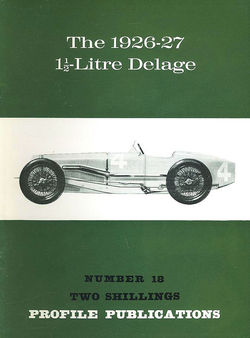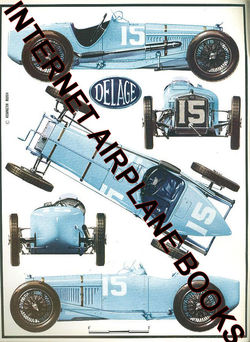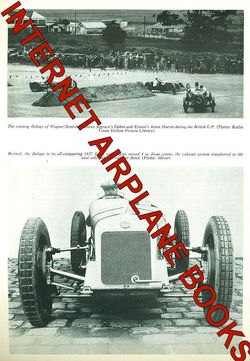AUTOMOBILE PROFILE 18 1926-27 1
½-LITRE DELAGE GRAND PRIX RACE CARS_ENGINE_CHASSIS_DETAIL
SOFTBOUND - ILLUSTRATED WITH VINTAGE PHOTOGRAPHS, COLOR
SCALE VIEWS, DETAIL DRAWINGS, CUTAWAYS AND EXTENSIVE TEXT (DESIGN, DEVELOPMENT,
PERFORMANCE, VARIATIONS, MODIFICATIONS, SPECIFICATIONS, PRODUCTION & RACING
RESULTS)
-------------------------------------------------------------------------------------------------
Additional Information from Internet Encyclopedia
Delage was a French luxury automobile and racecar company
founded in 1905 by Louis Delage in Levallois-Perret near Paris; it was acquired
by Delahaye in 1935 and ceased operation in 1953.
The 1920s were really the first "Golden Age" of
Delage. The most famous were the DE and DI: 4 cylinders of about 2 liters and
11 hp. Delage also attempted to compete with Hispano-Suiza, with the GL of 30
hp and 5954 cc, with some success. After that came a new generation of
six-cylinder cars, like the MD (3174 cc) and DR (2516 cc), the best-selling
vehicle in the history of the brand, designed by engineer Gaultier.
Both the CO and DO were replaced in 1922. The CO became the
CO2, which changed to an overhead valve twin-plug head, producing 88 hp (66 kW;
89 PS), while the DO was supplanted by the DE with a 2,117 cc (129.2 cu in) (72
by 130 mm (2.8 by 5.1 in)) sidevalve four and, unusual in a production car even
in this era, four-wheel brakes. The CO2 completed the Paris-Nice run in 16
hours, an average of 67 km/h (42 mph).
The next year, the new 14 hp (10 kW; 14 PS) DI also
switched to OHV with a 2,121 cc (129.4 cu in) (75 by 120 mm (3.0 by 4.7 in))
four, fitted with magneto ignition and thermosyphon cooling; all had four-speed
gearboxes and Zenith carburettors. At the other end of the scale, the GL (Grand
Luxe), also known as the 40/50, replaced the CO2, being fitted with a
magneto-fired 5,344 cc (326.1 cu in) (90 by 140 mm (3.5 by 5.5 in)) overhead
cam six.
In 1923, a hillclimb car with DI chassis, larger wheels
and tires, and 5,107 cc (311.6 cu in) (85 by 150 mm (3.3 by 5.9 in)) CO block
(with three Zenith carburetors) was produced.[7] Delage scored successes at La
Turbie and Mont Ventoux. This car was joined by a 10,688 cc (652.2 cu in) (90
by 140 mm (3.5 by 5.5 in)) V12, which broke the course record at the Gaillon
hillclimb, with Thomas at the wheel. Thomas would set the land speed record at
Arpajon in this car, at a speed of 143.24 mph (230.52 km/h), in 1924. A 1925
car had a 5,954 cc (363.3 cu in) (95 by 140 mm (3.7 by 5.5 in)) six, again
using the GL block, with four valves per cylinder and twin overhead cams.
Driven by Divo, it broke the Mont Ventoux course record in its debut. It would
be destroyed by fire at the Phoenix Park meet in 1934.
The 1924 and 1925 DIS, with a 117 in (3,000 mm)
wheelbase, switched from Rolls-Royce-type locking wheel hubs to Rudge
knock-ons, better cam, and bigger valves, while the 1925 and 1926 DISS on the
same wheelbase. Some of the DISes were bodied by Kelsch. The DIS became the
Series 6 in 1927, switching to coil ignition and water pump.
In 1926, Delage introduced the DM, with a 3,182 cc (194.2
cu in) (75 by 120 mm (3.0 by 4.7 in)) six, which made it emblematic of the era
for the marque. The high-performance DMS had hotter cam, twin valve springs,
and other improvements. A DR, with a choice of 2.2- and 2.5-liter sidevalve
engines, also briefly appeared.
In 1923 Louis Delage returned to competition with the
innovative 12-cylinder 2-liter type 2 LCV. This car won the 1924 European Grand
Prix in Lyon and the 1925 Grand Prix of ACF Montlhéry. The 12-cylinder DH (10,5
liters) of 1924 beat the world speed record on the highway, at 230 km/h (143
mph).[citation needed] A Delage 155 B won the first Grand Prix of Great-Britain
in 1926, driven by Louis Wagner and Robert Senechal. The production of cars
continued with the DI and the DI S SS. The DM evolved into the DMS and DML,
equipped with a 6-cylinder 3-liter engine designed by Maurice Gaultier.
Delage's Grand Prix effort saw a Plancton-designed 1,984
cc (121.1 cu in) (51.3 by 80 mm (2.02 by 3.15 in)) four overhead cam V12. The
110 hp (82 kW; 110 PS) car, driven by Thomas, fell out of the French Grand Prix
in 1923, but went on to perform well for the bulk of the 1923 and 1924 season.
With supercharger added in 1925, bringing output to 195 hp (145 kW; 198 PS), it
won at Montlhéry and Lasarte, proving as fast as the Alfa Romeo P2, but rarely
racing it directly. This car was supplanted in 1926 by a Lory-designed
supercharged 1.5-liter twincam straight eight of 170 hp (130 kW; 170 PS);
capable of 130 mph (210 km/h), it was the company's last Grand Prix entrant.
Always
passionate about racing, Louis Delage designed an 8-cylinder 1500 cc, the type
15 S 8. This car won four European Grands Prix races in 1927, and won Delage
the title "World Champion of Car Builders" that same year.







